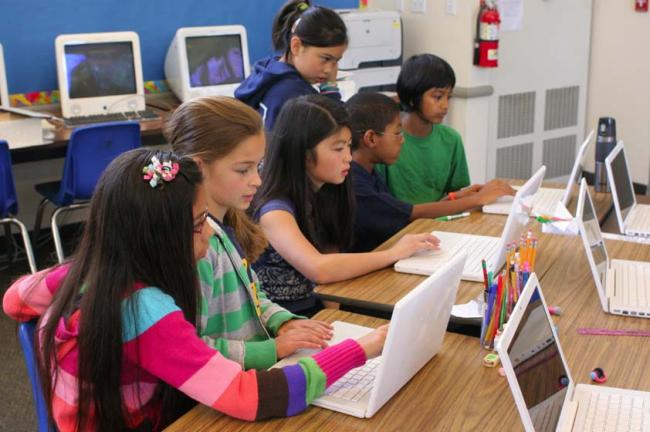Leveraging Social Media in the Elementary Classroom
By Debbie Marsh Communicator February 2015, Volume 38, Issue 6
By Debbie Marsh
Communicator
February 2015, Volume 38, Issue 6
At South Elementary School in Mooresville, North Carolina, we used the 100th day of school last year to explore technological advances. In our school’s media center, we erected a technology museum highlighting the evolution of everyday items that enable us to communicate electronically, listen to music, watch movies, and play games. Exhibits examined the progression from manual typewriters to laptops, rotary phones to smart phones, 16 mm. projectors to interactive whiteboards, and vinyl record players to iPods.
The world in which these students live has changed drastically from the one their teachers experienced at the same age. The workplace they will inherit probably does not even exist. Yet, what does their classroom look like? Is it preparing them for the world they will inherit? Unfortunately, too often the answer is no.

The Challenge: Connecting the Classroom
The Common Core calls for a dynamic and connected learning environment where learners have access to an abundance of digital resources and experts beyond their classroom walls. However, even schools equipped with the latest technology may not be preparing their students for the demands of the new standards. Schools must also change their pedagogy and embrace the forums through which 21st century citizens communicate.
Fortunately, though, our district is setting an example others may emulate. Since 2008, Mooresville Graded School District (MGSD) in Mooresville, North Carolina, has embarked on an ambitious digital conversion initiative to better prepare its students to be successful global citizens in the 21st century. Every third- through twelfth-grade student was issued a laptop; K-3 classrooms are equipped with tools including interactive white boards, iPads, MacBooks, and Mac Minis. The district also recently installed more robust wireless in all the schools. With the 21st century tools in place, we turned to better using and modeling technology and social media use.
Leveraging Social Media
Teachers have been taught to tap into a student’s prior knowledge and experiences to find the “hook” on which the new content can rest. Discrete, disconnected facts or processes have little value to the learner and rarely make it to long-term memory unless a connection makes it relevant for the learner. Plus, we’re social creatures who crave interconnectedness—and we learn best from those with whom we have a personal connection. This is why social media is a perfect teaching tool, and a growing network of connected teachers is using social media in their classrooms.
At South Elementary (which serves pre-K to third grade), two teachers have made social media integral parts of their classroom experience. Here are their strategies.
- Blogging as a Class; Reinforcing Digital Citizenship. Kindergarten teacher Kitch Deaton uses blogs and Twitter to connect her classroom to stakeholders and connect her students to other classrooms. By blogging two to three times a week for 15 minutes at the end of the day, Ms. Deaton reinforces academic skills like sequencing, narrative writing, punctuation, spelling, audience, and author’s purpose. She facilitates the keyboarding for her students, but they decide together, as a class, what is said on the blog. She uploads pictures from her phone to a site on which Ms. Deaton can control viewers and approve responses.
The class tweets with other classes across the country, learning about other communities, playing games with other classes, and developing an understanding of their similarities with other kindergarten students.
This process is very safe, but nothing is left to chance. Across the school, we teach digital citizenship with the Common Sense Media curriculum. We connect our character education objectives and digital citizenship objectives. We encourage children to apply the school universal rule, “Be Safe, Be Respectful, Be Responsible” to their digital world. Most importantly, they are then provided the opportunity to authentically practice this through social media.
- Skyping to Forge Global Connections. In a second grade class, Cheryl McCrorey uses Skype to bring the world into her classroom. Her team participates in the Global Read Aloud program, which led to Skype chats with several children’s authors. Then, Ms. McCrorey began an ongoing “Mystery Skype” chat in her class. Children use maps, journals, and questions to guess the location of a mystery class though a process of elimination. Through this activity, Ms. McCrorey’s children learn physical and cultural geography, develop questioning skills, analyze data, and problem-solve as a team. Of course, the best part is the relationships class has developed with classes all over the country and the world! These students truly develop a keen awareness of their place in the world by examining the similarities and differences between themselves and their Skype buddies.
Skeptics and detractors who quickly point to the abuses or challenges social media can cause miss an important point. Social media is here and it’s not going away. It is an integral part of the world our children have inherited. We must teach and model the responsible, safe, and respectful say in which social media must be used and model the incredible ways it can enhance our learning and our lives. Our classrooms must prepare our students for the connected world in which we now live.
Debbie Marsh is principal at South Elementary School in Mooresville, North Carolina.
—
Copyright © 2015. National Association of Elementary School Principals. No part of the articles in NAESP magazines, newsletters, or website may be reproduced in any medium without the permission of the National Association of Elementary School Principals. For more information, view NAESP’s reprint policy


